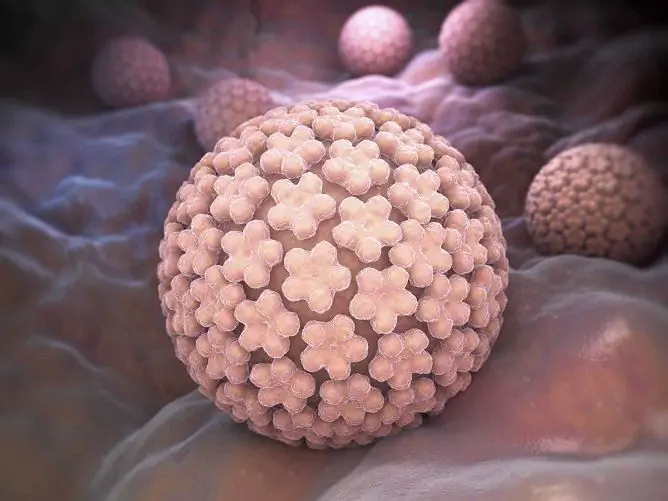- Author Rachel Wainwright [email protected].
- Public 2023-12-15 07:39.
- Last modified 2025-11-02 20:14.
Signs and symptoms of menopause in women and how to deal with them
Women between the ages of forty and sixty often experience specific discomfort caused by menopause or menopause. The article provides an overview of the causes and stages of the climacteric period, its first signs, symptoms and treatment. Before using drugs, consult your gynecologist.

What is menopause?
Menopause, or climacteric period, is, in the general case, the normal physiological period of restructuring of the body with the extinction of the functions of the reproductive system due to aging. In women, it occurs between 49 and 52 years, is acute and fast (within 7-14 years), is considered to occur in the absence of menstrual bleeding for a year, before they become irregular, and is called menopause.
Menopause is literally a "pause" in menstruation, although in essence it is their complete "stop." After this period, a woman loses the ability to bear and give birth to children. Some women perceive it as a state of health, illness, while others are part of growing up, a positive symbol of old age. Perception depends on how easily this period will be survived.
In order to figure out what to do with menopause, you need to understand its causes, stages of development and symptoms.
Causes of menopause
Menopause develops normally due to age-related ovarian failure, since the supply of eggs in them is depleted. Associated with this are a decrease in blood levels of estrogen and progesterone and an increase in follicle-stimulating (FSH) and luteinizing (LH) hormones. Since adipose tissue also synthesizes estrogen, women in the body have a milder climacteric period.
If the menopause in women develops before the due moment, they talk about premature ovarian failure. It can develop from ovarian removal, polycystic disease, endometriosis, autoimmune diseases, diabetes mellitus, cigarette smoking, and excessive BMI (if there is a lot of adipose tissue, it produces too much estrogen, and by the principle of negative feedback, the ovaries stop producing it). However, in 80% of cases, menopause too early does not have a well-established cause.

Stages of the climacteric period
Actually, menopause begins a couple of years before the last menstruation and ends a few years after it. It is preceded by premenopause and followed by postmenopause.
- Premenopause can begin at forty to fifty years: the regularity and abundance of menstruation is disrupted, a decrease in libido is felt, and headaches appear.
- Perimenopause: fluctuations in the level of estrogen in the blood occur and these fluctuations are manifested by the occurrence of so-called hot flashes, or hot flashes - sharp reddening of the body with a feeling of heat, sweating and palpitations, lasting from two minutes to half an hour.
- Menopause occurs on average one year after the last menstruation and is manifested by symptoms of a drop in estrogen levels: an increase in bone fragility with a risk of osteoporosis, an increased risk of diabetes and cardiovascular disease.
- Postmenopause: the unpleasant manifestations of menopause subside, headaches go away, libido may even recover, but there is no more menstruation, children cannot be had, and age-related diseases of bones, heart and other organs do not recede.
Since it can be difficult to distinguish perimenopause, Russian classification often forgets about it or consciously and deliberately ignores it.
Symptoms and first signs
As mentioned above, premenopause can be recognized by a violation of the usual menstrual cycle. The frequency of menstruation is disturbed: they may occur every 2-7 days, or may not occur for months; the volume of bleeding changes: it becomes less or much more, with inclusions, lumps.
Menopause symptoms usually develop in women after the age of 45 and are reduced to pre- and perimenopause, which is why they are usually easy to detect, and especially by the most striking and well-known manifestation: hot flashes. At the same time, symptoms after 50 are reduced to menopausal effects, and after 55 - postmenopausal.
It is important to note that if bleeding continues after menopause, this is an extremely alarming sign that may indicate the development of malignant neoplastic diseases and requires an urgent visit to a doctor - this manifestation contradicts the normal course of menopause in women and does not allow self-treatment.
The normal effects of menopause are divided into uterovaginal, other physiological, psychological and long-term:
- Uterovaginal: In addition to the symptoms listed above, include soreness, dryness and atrophic vaginitis - thinning, decrease and loss of elasticity of the external and internal genital organs.
- Other physiological: persistent fatigue, pain in joints and muscles, back, stiffness, breast enlargement and tenderness, headaches and dizziness, dryness, itching and tingling of the skin, sweating, palpitations, frequent urination with unsuppressed urges, insomnia and compensatory weight gain for maintaining estrogen levels.
- Psychological - effects that affect memory and mood: anxiety, nervousness, mood swings, loss of sexual desire, preclinical depression, which can spill over into clinical depression, and memory impairment caused by a decrease in estrogen in the brain and redistribution of blood to the periphery of the body, and therefore the blood supply to the brain deteriorates.
- Long-term effects: increased risk of osteoporosis, lung and heart disease, atherosclerotic vascular changes.
It is extremely rare that the symptoms of menopause in women begin at the age of 40 and earlier, but this is usually associated with preliminary disturbances in the work of the uterus or its surgical removal.
Treatment of menopause in women
Menopause is not a disease or disorder, but a natural stage of life. Treatment is required not so much for menopause as for the undesirable physiological and psychological effects caused by it, which can significantly reduce a woman's quality of life. The most appropriate therapy is palliative, supportive, relieving discomfort.
Unfortunately, one of the best remedies for menopause is unknown: hormonal and non-hormonal drugs are used. Therefore, it remains to consult with doctors about the prescription of prescription drugs and additionally take dietary supplements.
It is accepted to use hormone replacement therapy with female sex hormones, selective estrogen receptor modulators, corrective effects of estrogen, depending on its level in the blood; psychotropic drugs that regulate psychological processes that reduce depression or insomnia; psychotherapy and physical exercise, which also affect psychological processes; soy isoflavones - phytoestrogens of plant origin; and supportive measures aimed at eliminating individual symptoms.
Hormone replacement therapy
Estrogen and progestin reduce hot flashes. They can be used as a pill or a transdermal patch, but in the latter case, there is a risk of thrombosis. Testosterone is added to restore sexual performance, but can lead to abnormal hair growth and acne. Hormone therapy can be used only for short-term and low doses and can only be prescribed by a doctor.
Hormone replacement therapy is contraindicated for many women, then phytoestrogens come to the rescue

Phytoestrogens
The most studied of them are soy isoflavones, which are found in large quantities in soybeans, peas, other legumes, pomegranates, dates, sunflower seeds, cabbage, and clover. In terms of structure and effect, isoflavones are close to the main estrogens - estradiol and estrone. Therefore, they compensate for the lack of human estrogen during menopause in women.
It is appropriate to combine phytoestrogens with other active ingredients. Thus, the non-hormonal dietary supplement "Flavia Night" in capsules contains phytoestrogens genistein and daidzein (soy isoflavones), as well as vitamins of group B (B6, B9 and B12), melatonin, alpha-linolenic acid, calcium, magnesium and vitamin D3. Taken together, this characterizes it as a good remedy for hot flashes, sweating and other phenomena with menopause.
Genistein and daidzein compensate for estrogen deficiency. Vitamins B6, B9 and B12 contribute to good neurocirculation, offsetting the psychological effects of menopause. Magnesium also helps with this. Melatonin is a natural sleep neurotransmitter that most physiologically and effectively relieves insomnia. Alpha-linolenic acid is an omega-3 fatty acid that helps to optimize the lipid profile of the blood and reduces the risk of atherosclerosis. Calcium and vitamin D3 help in the prevention of osteoporosis. Adequate calcium intake helps to strengthen the skeleton, and vitamin D3 is needed for calcium to be absorbed by the body.
Thus, "Flavia Night" in capsules has a complex effect on all links of pathogenesis and can help relieve the symptoms of menopause in women.

Psychotropic drugs
Antidepressants such as paroxetine are used to treat moderate to severe menopause vasomotor symptoms. However, they can impair appetite and aggravate insomnia, cause nausea and constipation. Gabapentin and clonidine reduce the frequency and severity of hot flashes but worsen headaches and, conversely, cause daytime sleepiness, although they can worsen insomnia. Of course, they are prescribed by a doctor.
Psychotherapy and physiotherapy
Mindfulness practices and cognitive-behavioral therapy can alleviate the subjective perception of menopause symptoms, but some research has questioned their effectiveness.
Exercise can increase the production of endorphins, which are responsible for feelings of joy, which decrease as the level of estrogen in the blood decreases. They also help to reduce BMI, an excessive value of which contributes to the development of unwanted vasomotor symptoms. However, some studies reject the effectiveness of such physiotherapy.
Supporting activities
In addition to the obvious physiological and psychological undesirable symptoms, correction also requires little things that generally worsen the perception of menopause:
- The lack of sexual lubrication is compensated by vaginal moisturizers and vaginal lubricants: the former solve the problem of general dryness, and the latter facilitate intercourse with penetration.
- Dryness and thinning of the vagina, that is, vaginal atrophy, can be solved by local hormone replacement therapy - estrogen ointments.
- Hot flashes can be relieved by drinking plenty of cold drinks, working in cool, air-conditioned rooms, wearing light clothing, and avoiding hot drinks and hot food.
- Support groups and one-to-one communication with compassionate loved ones can reduce depression, anxiety, and insomnia.
- The risk of developing osteoporosis can be reduced by regular, but not excessive physical activity, smoking cessation, calcium and vitamin D intake.
- Psychological disturbances can also be relieved by taking B vitamins and a natural sleep modulator, melatonin.
- The risk of atherosclerosis can be reduced by taking omega-3 fatty acids, eating fiber, and general weight and fat control.
Found a mistake in the text? Select it and press Ctrl + Enter.






